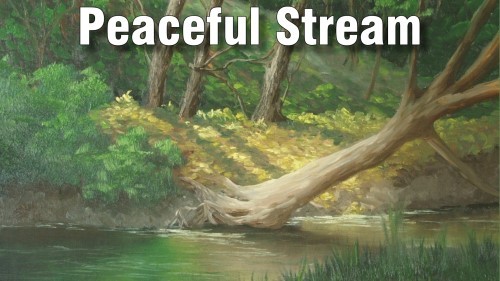How to Paint Sand Dunes on The Beach in Oil
Skill Level : 1 Beginner, 2 Intermediate
Medium : Oil Painting
Subject : Seascapes
Tutor : Nolan Clark
Avg Rating : 
Gold Level or Higher Class
Class Description
You will paint a path through the sand dunes leading to the beach.
In this class you will learn :
1) How to paint sand dunes on the beach
2) How to paint the grasses and other plants growing on the beach
3) How to use the foreground to add mystery and intrige to a painting.
4) How to paint the sea in the distance
5) and much more...
Latest Reviews


This was so fun as always Nolan takes you on a wonderful painting journey. He rocks !
Mireille Fournier
Class Tutorial
Planning

Print out the template and combine the tiled pages together. If you are new to working with tiled templates, watch as Nolan explains how to do it. Transfer the tiled template to the canvas using whatever transfer technique you prefer. Keep the template attached and hanging in back of the canvas for easy reference.
Sky

First, tape off the horizon line. Lay down a very thin layer of white paint in the sky area, slightly overlapping the tops of the mountains. This white layer will help keep the sky colours from appearing too bright. Then mix a very pale yellow to lay on top on the sunny side of the painting.

Now mix some traditional blue sky colour. Using a clean brush, apply the sky colour at the far corner. Lighten the tone as you move closer to center. Have the blue just fade up to the yellow, being careful to not go over the yellow or you could end up with a green tinge.
Mix an even darker blue and dab that on as the shadows for the yellow clouds.
Distant Sand Dunes

Mix a yellow base for the sand dune colour. Add a bit of sky colour to it. Mix a more intense hue, also. Then dab on the colours randomly at the base of the mountain. Add lighter sand colour in the area below the mountain. Keep going lighter as you approach the beach.
Now darken both the blue and the yellow sky colour mixes. Dab on some yellow clouds, then some of the darker blue clouds. Check to see if your corners are dark enough to create a “looking-in” effect, forcing your eye to the center of the painting.
Distant Mountains

Remove the masking tape from the horizon line and put it above, following the technique that Nolan uses to keep the top part of the tape from touching the canvas. Use the dark cloud colour to paint in the distant mountain. Use the yellow sky colour to add highlights and contour to the mountain.
Now mix up a darker, more greenish hue for the next mountain. Make a light and a dark version.
Start with the darker green and form the outline of the distant mountains on the far left. Following its contour, add dabs of colour, getting lighter as you go down the mountain. Using some green at full strength, make the contours on the shadow side of the mountain. If need be, add the lighter colour for additional highlights.

Add a purplish mix to the sand colour and make shadows on the sand. Add a little extra drama by dabbing in some vegetation on the sand.
Sea

Mix up a batch of sea colour. Start by blocking in sea colour; then, using the same brush, add in some sky colour. Go a bit lighter as you near the sand, even overlap it. Use a lighter colour as you do the water in the inlet. Add the wet-sand effect along the inlet.

Use Nolan's technique to add sky and sun colours on the water in the inlet.
Using a very thin, inky-like paint, pop in some waves rolling up onto the shore. Add a dark sea blue shadow under the waves.
Add some darker sand colour to the left of the painting to draw the eye into the painting. Add a bit of shadow.
Beach
Mix a slightly darker sand colour. Block that onto the flat area of sand in the middle of the painting. Blend it into the inlet.
Add a little drama by lightly brushing a bit of sand colour in the middle of the inlet.
Add some shadows to the beach.
Enjoying This Tutorial?
Sand Dunes

Mix several shades of sand colour. Use the lightest paint on the sunny spots, then move gradually to the foreground with the darker colours. Work in some intermediate shadow areas next. Scrub on the darkest colour at the edges of the sand and across the bottom. Adjust the colours if they look too brown.

Be sure to follow the contours of the dunes as you paint in the remaining shades. First work the darks into the lights, then the lights into the darks.
Grass - Planning

Paint shadows into the last remaining blank spot on the canvas as a base for the grasses.
Examine the clumps/patches of grass you will be painting. Also note the rough texture of the sand.
Grass - Colour Planning

Mix the colours you will need for the grasses. Use your artistic license in varying the colours of the grasses if you wish.
Grass - Painting

Start by flicking out some very light colored grasses randomly around the dunes. Continue doing the same with alternating colors and lengths, creating layers of grass. Work gently. End with a few bright flicks. Paint the shadow for each clump, following the contour of the land. Squiggle on a few lines to show the undulations in the sand. Take another brush and remove any hard lines.
Path

Use Nolan's technique to add footprints.
Finishing Up

Personalize the painting by adding birds, more footsteps, etc.

You May Also Like |








